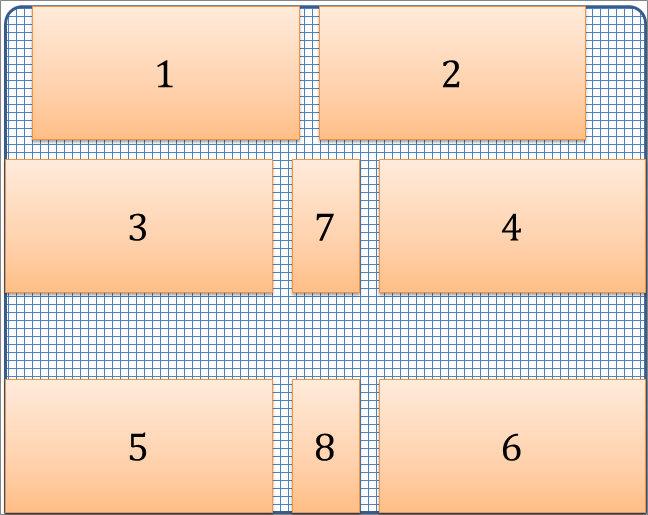Keywords: Optimum loading plan, Best loading plan, Loading plan optimizer, Cargo optimizer, Loading box optimizer, Store box optimizer, 2D bin packing problem, 2D box packing
In testing, frozen-food storage or food-freezers in refrigerating appliances are loaded with lean-beef simulant called "test packages". Rectangular test packages used in loading plan according to IEC 62552 - ISO 15502 have three basic sizes (with height 50 mm):
13.3.2.6 Free air spaces of 15 mm minimum (calculated from the nominal dimensions of the test packages), as far as possible equal, shall be left between adjacent stacks of test packages.
The use of spacers to maintain free air spaces between stacks of test packages is permissible provided that the spacers are of the smallest possible cross-section and of the lowest possible thermal conductivity and are placed in such a way that they do not significantly interfere with normal air circulation.
In testing, frozen-food storage or food-freezers in refrigerating appliances are loaded with lean-beef simulant called "test packages". Rectangular test packages used in loading plan according to IEC 62552 - ISO 15502 have three basic sizes (with height 50 mm):
Size A (represents 1 kg): 200 mm x 100 mm
Size B (represents 0.5 kg): 100 mm x 100 mm
Size C (represents 0.25 kg): 100 mm x 50 mm
Loading plan is almost based on the two dimensional area of horizontal surface intended for loading. Once the basement of the loading plan is found, then this plan can be repeated one on the top of another in upward direction.
The following Excel toolbox which is included in cold-appliances add-in is used to calculate the optimum loading plan according to IEC 62552 - ISO 15502 standard for a given rectangular loading box because loading is an iterative procedure.
The following Excel toolbox which is included in cold-appliances add-in is used to calculate the optimum loading plan according to IEC 62552 - ISO 15502 standard for a given rectangular loading box because loading is an iterative procedure.
The user-form looks like the following capture:
The following are some iterations (from 63 iteration) of loading plan of box of size 480 mm x 380 mm and two round corners of radius 16 mm.
Box boundaries may be physical or load limit line. The common cases are:
- Four physical walls in chest freezers or upright freezer drawers
- Three physical walls and one load limit line, door, or flap
Iteration 1:
Iteration 28:
Iteration 61:
The last one is optimum loading plan as it has the maximum load with maximum number of 1 kg packages 200 mm x 100 mm. The following conditions are achieved according to the standard:
13.3.2.1 The food freezer compartment or cabinet and any frozen-food storage compartment or cabinet shall be filled with as many test packages as it can hold, the test packages having previously been brought to a temperature approximately equal to the classification temperature of the compartment.
13.3.2.2 On each horizontal surface intended for storage, the largest possible number of stacks of 1-kg test packages, having a base of 100 mm ×200 mm, shall be made.
NOTE: A stack is a number of packages piled on top of one another (faces with largest surface horizontally); the term does not necessarily imply that packages form a “straight” pile.
Stacks of packages shall be placed in direct contact with horizontal loading surfaces and vertical surfaces (this applies to 0,5-kg as well as 1-kg packages).
Test packages priority: If necessary, the loading may be completed by stacks having a base of 100 mm ×100 mm made up of 500-g packages laid flat, and then finally by stacks having a base 50 mm ×100 mm made up of 125-g or 250-g packages, also laid flat, or else 25 mm ×100 mm ×200 mm 500 g packages.
13.3.2.4 Stacks of packages shall be placed in direct contact with the horizontal loading surfaces and vertical surfaces except in the following cases:
a) When the vertical surface is the inner surface of a door, the stacks shall be loaded as follows:
– if there is a marked load-limit line, the packages shall be loaded up to that line (see Figure 16 a));
– if there is no load-limit line, but a natural load limit, the packages shall be loaded up to that limit.
13.3.2.6 Free air spaces of 15 mm minimum (calculated from the nominal dimensions of the test packages), as far as possible equal, shall be left between adjacent stacks of test packages.
The use of spacers to maintain free air spaces between stacks of test packages is permissible provided that the spacers are of the smallest possible cross-section and of the lowest possible thermal conductivity and are placed in such a way that they do not significantly interfere with normal air circulation.





No comments:
Post a Comment